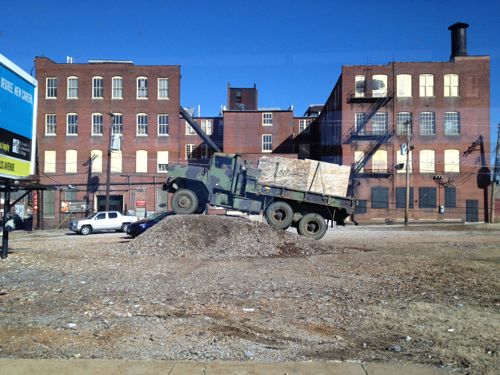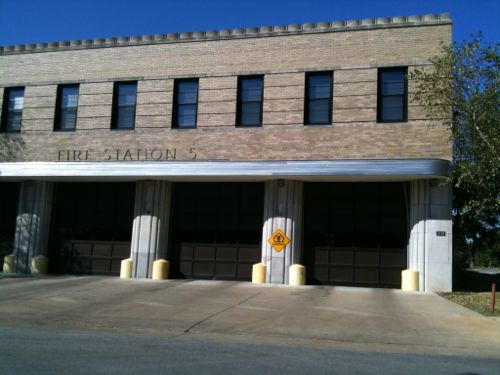Urban Renewal Officially Ended In 1974, Still Alive In St. Louis
The redevelopment process commonly known as Urban Renewal, in retrospect, was largely a failure:
After World War II, urban planners (then largely concerned with accommodating the increasing presence of automobiles) and social reformers (focused on providing adequate affordable housing) joined forces in what proved to be an awkward alliance. The major period of urban renovation in the United States began with Title I of the 1949 Housing Act: the Urban Renewal Program, which provided for wholesale demolition of slums and the construction of some eight-hundred thousand housing units throughout the nation. The program’s goals included eliminating substandard housing, constructing adequate housing, reducing de facto segregation, and revitalizing city economies. Participating local governments received federal subsidies totaling about $13 billion and were required to supply matching funds.
Sites were acquired through eminent domain, the right of the government to take over privately owned real estate for public purposes, in exchange for “just compensation.” After the land was cleared, local governments sold it to private real estate developers at below-market prices. Developers, however, had no incentives to supply housing for the poor. In return for the subsidy and certain tax abatements, they built commercial projects and housing for the upper-middle class. Title III of the Housing Act of 1954 promoted the building of civic centers, office buildings, and hotels on the cleared land. Land that remained vacant because it was too close for comfort to remaining slum areas often became municipal parking lots. (source)
Jane Jacobs’ 1961 book The Death and Life of Great American Cities rebuked the ongoing land clearance policies advocated by supporters of urban renewal. By the late 1960s one of St. Louis’ most prominent urban renewal projects — Pruitt-Igoe — was a disaster. Before the 20th anniversary the first of 33 towers were imploded in 1972 — urban renewal was unofficially over.
In 1974 it was officially over:
The Housing and Community Development Act of 1974 emphasized rehabilitation, preservation, and gradual change rather than demolition and displacement. Under the Community Development Block Grant program, local agencies bear most of the responsibility for revitalizing decayed neighborhoods. Successful programs include urban homesteading, whereby properties seized by the city for unpaid taxes are given to new owners who promise to bring them “up to code” within a given period—either by “sweat equity” (doing the work themselves) or by employing contractors—in return for free title to the property. Under the Community Reinvestment Act, lenders make low-interest loans to help the neighborhood revitalization process. (same source as first quote)
But forty plus years later the St. Louis leadership continues as if nothing changed. The old idea of marking off an area on a map to clear everything (homes, schools, businesses, churches, roads, sidewalks) within the red lined box remains as it did in the 1950s. The message from city hall is clear: don’t invest in North St. Louis because they can & will walk in and take it away.

What are the scenarios at this point?
A) National Geospatial-Intelligence Agency selects the city option:
- Businesses, residents, churches, etc are displaced.
- A 100-acre swath is purchased and cleared.
- The federal government builds a fortress-like campus, few workers would leave at lunch.
- No benefit to the surrounding neighborhoods, access to public transit cut off by monolithic campus.
- Adjacent areas now threatened as the next target for clearance, further eroding those areas.
- Fire Station Number 5 would remain, but because of the new campus, firefighters would be unable to quickly reach the area to the West of Jefferson/Parnell.

B) National Geospatial-Intelligence Agency selects another option:
- Nobody buys into this area because it’s now a known target area.
- It declines further because it’s a known target area.
- It’s taken later for some corporate campus.
C) An alternative if National Geospatial-Intelligence Agency selects another option:
- The city/community works with Paul McKee, existing businesses and property owners to develop a plan to revitalize the Cass & Jefferson/Parnell corridors and to coordinate with a new street grid in the long-vacsnt Pruitt-Ogoe site.
- The existing street grid is left fully intact.
- Infill planned with a variety of residential units with a concentration of retail & office at Cass & Jefferson.
But this won’t happen, St. Louis is forever stuck in the middle of the 20th century. Clearance for a new stadium and a QuikTrip are other current examples. It has been nearly 70 years since St. Louis adopted Harland Bartholomew’s City Plan and we’ve yet to stray from the thinking he outlined.
Here are the results from the Sunday Poll:
Q: Should the City of St. Louis use eminent domain powers to assemble a site if the National Geospatial-Intelligence Agency selects the city option?
- No 20 [44.44%]
- Yes 14 [31.11%]
- Maybe 8 [17.78%]
- Unsure/No Opinion 3 [6.67%]
We shouldn’t be willing to raze 100 acres to retain earnings tax revenues. If there was hope the campus would help the surrounding area it might be a fair tradeoff, but it’ll further deteriorate and isolate. Still, this urban renewal mindset is so engrained I’m not sure we’ll ever break free of it.
Perhaps I should just give up?
— Steve Patterson
You, rightly, want to blame Urban Renewal, for its failures. You touch on CDBG and urban homesteading as potential successes. You imply that benign neglect may be the best solution. And I continue to point out that you can’t force the private sector to do something that they don’t see as being profitable, any more than you can force any individual to live in a distressed neighborhood IF they have the resources to live in a better one!
http://cityobservatory.org/lost-in-place/ . explains A LOT! Poverty sucks, and concentrated poverty is both self-sustaining and drives away investment. I certainly don’t think that the city’s proposal for the National Geospatial-Intelligence Agency is a great one, for the exact reasons you outline, but I get why the city is pursuing it – $$$$$ – plus it’s one of the few, viable, big opportunities currently “on the table”, and losing all those jobs would negatively impact the city.
However, I’ll also argue that the “urban renewal mindset”, of today, is substantially different than the assumptions and the goals put forth in the 1950’s and ’60’s. Back then, the intentions were more “pure’, even if the results didn’t always deliver. Today, most large-scale, government-funded, land assemblages are done solely to hold onto and to grow local tax revenues. The alternative, unfortunately, is that projects requiring large parcels of land will simply skip existing urban areas, since doing land assemblages is such a PITA.
We can’t have a great city without tax revenues. We can’t have just the “good stuff” and say “no” to all the “bad stuff”. The city also isn’t, and shouldn’t, be frozen in time. Things are always changing. Things are being torn down, and (hopefully) being replaced by new and better. Unfortunately, especially, in north city, we’re missing a critical part of that equation – new going back in. And if we don’t change, don’t evolve, we will become increasingly irrelevent – see the definition of “rust belt”: http://en.wikipedia.org/wiki/Rust_Belt . What it really takes is a group of like-minded individuals wanting to make any area or neighborhood better . . .
I’ve lived here longer than you, we see things differently.
And I’ve lived in four different urban areas, each time for more than a decade, over a longer life, than you. Yes, we “see things differently”, we all do! I’m just not sure what point you’re trying to make. That St. Louis is somehow unique in its Urban Renewal failures? The only real difference between here and most other non-rust-belt American cities is that other cities have seen more success with (in spite of?) their urban renewal efforts than we have.
Most government programs start out with good intentions. Some, given the clarity of 20/20 hindsight, don’t deliver on what they promise. Others “evolve”, over time, often in response to special interests, and end up doing whatever they do differently. Does that mean that we shouldn’t try anything? Change anything? Because, god forbid, we might make a mistake? Get something wrong?
Economic migration is fascinating to track, and we have tons of data to look at, historically. What’s missing are all the little decisions that truly steer these trends. Why did Ford close their plant in Hazelwood and keep ones of the same vintage open in Louisville and Kansas City? Why has Pittsburgh bounced back better than St. Louis? Why is south city doing so much better than north city? Why do people want to move to Texas?
Based on your statements, I’m guessing that you’re opposed to using eminent domain for any large project in the city IF it involves demolishing ANY building that’s older than you. You want to believe in the fantasy that if even 20% of an old neighborhood remains, someday, all those missing “urban” structures will be replaced and we’ll get back the urban fabric that we’ve lost over the last century (along with 2/3 of our population).
I’m willing to fight change and progress, up to a point. But there is also a point, a tipping point, where any downward spiral only accelerates. The area defined in north city is well beyond that point. The aerial images show an area that isn’t mising a few teeth, it’s missing a whole mouth full! The same goes for the proposed stadium site and the new QT – none of these sites are currently thriving, under anyone’s definition. Sometimes, you just got to cut your losses and move on – we can’t “save” every old building in the city. We seriously need to focus on getting more new stuff built, to fill in the many, many, many gaps in our current urban fabric. And, if you want a real challenge, let’s figure out what we should do with the surplus property the NGA is going to leave behind!
My point was that we each have experiences that shape our views. I think by living here nearly 25 years, in 6 different buildings in 4 neighborhoods (CWE, Old North, Dutchtown, Mt. Pleasant, Downtown West), I just might have a deeper understanding of the problems we face and what those solutions might — and might not — be.
The city needs new leadership I don’t think the NGA, the new stadium, and Quick trip are popular with the voters, but our leader ship is stuck 30 years in the past. Also I feel with the NGA and Pruitt-Igo site the city leadership gave up with the near north side and wants the fed to deal with it.
Too often we get lazy and try to put things into black and white terms when in reality, there are many shades of gray. A perfect example in this case is the notion of “redevelopment”. That’s the more accurate term. Redevelopment takes many forms, and state law permitting blighting and redevelopment incentives has led to many good projects in STL city, both rehab and new construction. Much of N. City is a mess. The area of the geo spatial project is particularly FUBAR. It’s not reasonable to base all STL thinking based on the difficult challenges continuing in the old Pruitt Igoe area.